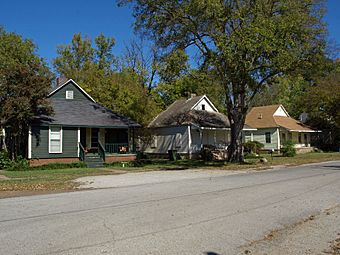Dallas Mill facts for kids
Quick facts for kids |
|
|
Dallas Mill
|
|

Dallas Mill around 1899, before it got bigger
|
|
| Location | 701 Dallas Avenue, Huntsville, Alabama |
|---|---|
| Built | 1891 |
| Architect | Lockwood & Greene |
| Architectural style | Italianate |
| Demolished | 1991 |
| NRHP reference No. | 78000496 |
| Added to NRHP | September 18, 1978 |
|
Dallas Mill Village Historic District
|
|

Houses on O'Shaughnessy Avenue
|
|
| Location | Bounded by Dickson St. NE. to Russell St. NE., Rison Ave. NE. to Pratt Ave. NE., Huntsville, Alabama |
|---|---|
| NRHP reference No. | 11000406 |
| Added to NRHP | June 27, 2011 |
The Dallas Mill was a large factory in Huntsville, Alabama, United States. It made cotton cloth, like sheets. It was the first of four big textile mills built in Huntsville. The mill started working in 1891 and closed in 1949. Later, it was used as a warehouse. Sadly, a fire destroyed the building in 1991. The mill also had a special village built for its workers. Both the mill and its village are important historical places. They are listed on the National Register of Historic Places.
A New Factory for Huntsville
In the 1880s, Huntsville was a small town. It had about 5,000 people. Leaders wanted to bring more businesses there. A group called the North Alabama Improvement Company helped. They looked for investors from the Northeast.
In 1890, a man named Trevanion Barlow Dallas agreed to build a cotton mill. He was a mill executive from Nashville, Tennessee. Other early investors included the North Alabama Improvement Company. Michael O'Shaughnessy, another industrialist, also invested. The Milliken family, who owned a big textile company, also helped. The mill officially started in 1891. It began making cloth on November 16, 1892.
When the mill opened, it was very large. It had 25,000 spindles and 704 looms. It employed 516 workers. This made it one of the biggest cotton mills in the South. Just eight years later, the mill doubled in size. It grew to 50,000 spindles and 1,541 looms. It employed 1,200 workers. The mill made bleached and brown cloth for shirts and sheets. It used about 20,000 bales of local cotton each year.
The Dallas Mill was one of the biggest employers in the area. This lasted until the 1930s. Around this time, workers at all Huntsville's cotton mills started to have problems. From July to September 1934, workers went on strike. This caused some trouble in Huntsville. Another strike happened in 1947. At that time, the mill had 700 workers. Two years later, only 300 workers remained. The mill worked part-time until July 1949.
The mill's equipment was sold. The building was bought by two businessmen for $175,000. They rented it to the Genesco Shoe Company. Genesco used it as a warehouse from 1955 to 1987. The mill was then used by a real estate developer. On July 24, 1991, a fire destroyed the building.
Mill Building Design
The main mill building was designed by a company called Lockwood, Greene & Co.. They were architects from Providence, Rhode Island. The building was built in the Italianate style. This style often features wide eaves and decorative brackets.
The building was first about 300 feet (91 meters) long and 110 feet (33 meters) wide. In 1900, it was made much longer, reaching 650 feet (200 meters). It had a low-pitched gable roof. This roof stuck out two feet from the sides. The windows were set deep into the walls. Two square brick towers stood above the roof. They had pyramidal roofs and held water tanks. Two brick chimneys from the boiler room were behind the main building.
Inside, each of the five floors had a central drive shaft. Pulleys were attached to this shaft. These pulleys powered the machines. Wooden columns supported the floors. The wooden window sashes could pivot. The top part pivoted inward. The bottom two-thirds pivoted from the center. This allowed them to stay open even when it rained. The older and newer parts of the building were separated by firewalls. A central staircase and elevator connected the floors.
After the big fire in 1991, most of the mill was gone. Only the riveted steel water tower remains today.
The Mill Village Community
In 1892, a group called the Huntsville Land Company was formed. Some of the mill executives started it. Their goal was to build homes for the mill workers and their families. By 1916, the village had 120 houses. It also had 74 tenement buildings. At its largest, the village had 350 houses. Most of these homes were sold to the workers in the mid-1940s.
Rison School was built in 1921. It was named after Archie L. Rison, the mill's general manager. The school was on the corner of Dallas Street and Oakwood Avenue. Over the years, it grew to serve students from first to twelfth grade. It became part of the Huntsville City Schools system. It operated as an elementary and middle school until 1967.
Dallas Park was built in 1928. Today, it is known as Optimist Park. The park was home to semi-professional baseball teams. These teams were sponsored by the mill. The local Optimist Club bought the park in 1949.
The mill village covers a large area. It goes from Oakwood Avenue south to Pratt Avenue. It also stretches from Andrew Jackson Way west to Dallas Avenue. The village was added to the National Register of Historic Places in 2011.
The records of the Dallas Manufacturing Company are kept at the University of Alabama in Huntsville.



